
Mid-roll ads 101: Everything you need to know
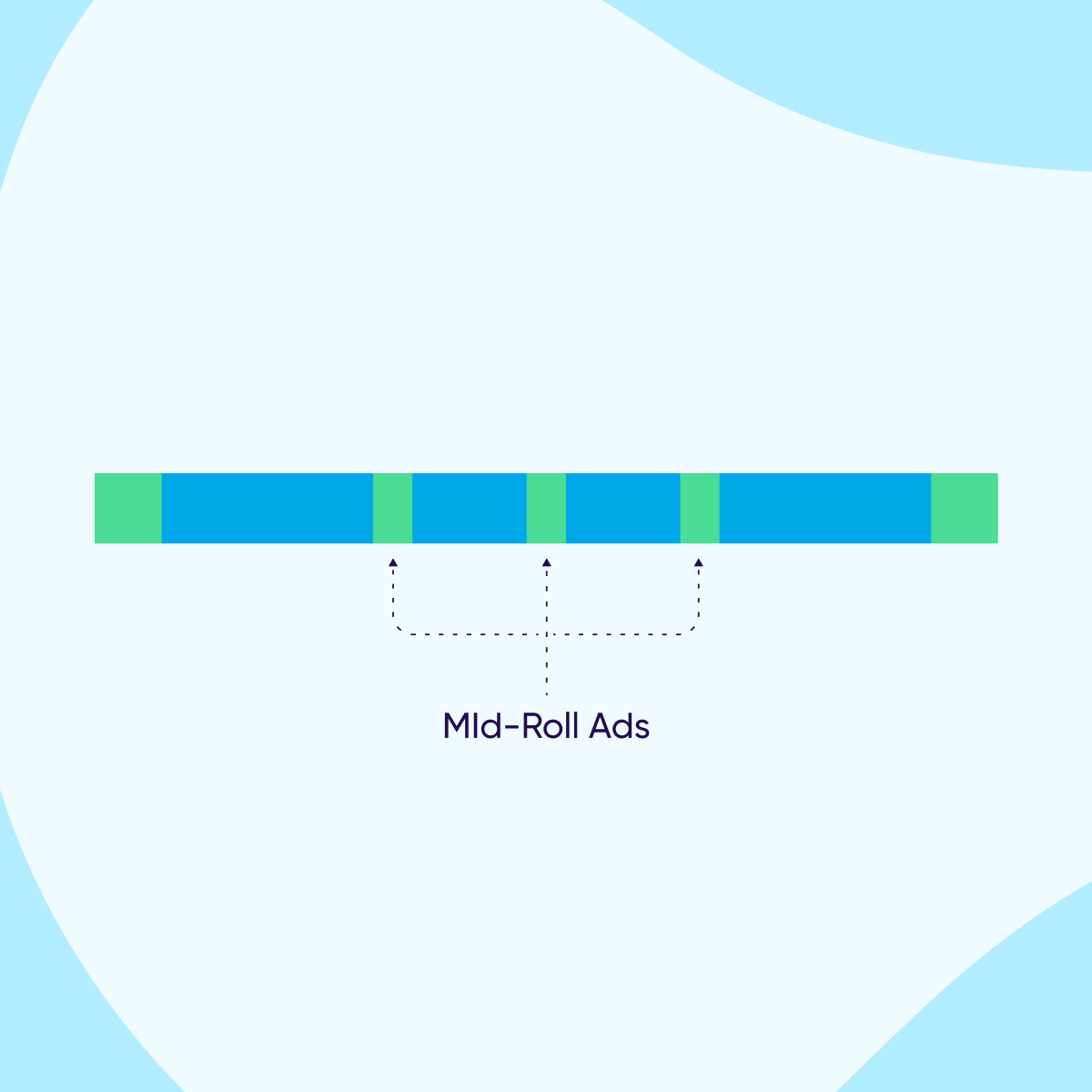
And now, a quick word from our sponsors…
For most people, this mini-intermission in a show or podcast is their cue to get up and stretch or grab a snack from the kitchen before the show continues. Today, we’ll share how marketers can take advantage of these advertising breaks — called mid-roll ads — to turn passive viewers or listeners into prospective customers.
What are mid-roll ads?
Mid-roll ads are video or audio ads that run in the middle of streamed content such as a show, podcast, or social media video. They differ from pre-roll ads, which run before the content starts, and post-roll ads, which run after it ends.
Which platforms use mid-roll ads?
Most social media platforms and over-the-top (OTT) streaming services offer mid-roll ads to advertisers. This generates a revenue stream for the publisher and engagement opportunities for the brand partners.
Here are three types of publishers you may want to consider for mid-roll ads:
- Social media platforms including Facebook, YouTube, and Snapchat
- OTT publishers including Netflix, Hulu, Apple TV, and Amazon Prime Video
- Podcast and audio publishers including Spotify, Stitcher, Pandora, and SiriusXM for longer audio content
As well as these established players, gaming and esports streaming services like PlayStation and Twitch are testing mid-roll ad formats.
Pros and cons of mid-roll ads
If you’re creating an online marketing strategy, you may not be sure of the best placement for your video or audio ads. Is mid-roll the best spot for your campaign, or should you take a different approach?
Mid-roll ads are great for top-of-the-funnel ad content to drive brand awareness with new audiences, but there are some drawbacks. Here are a few considerations for you to determine if mid-roll ads will help you reach your goals.
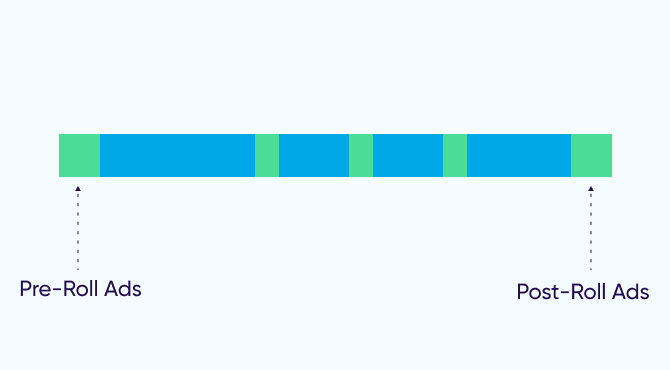
Benefits of mid-roll ads
- Mid-roll ads have high completion rates, since audiences are already invested in their show or video and want to continue it to the end (by “completion”, we mean watching or listening to an ad all the way through — note that this doesn’t always translate into action). As a result, they achieve 35% more impressions than post-roll ads, where viewers or listeners could be switching off.
- Advertisers see positive brand recall from mid-roll ads, particularly on larger screens. An IPG Media Lab and YuMe study found their message recall rate to be 27%, slightly above pre-roll at 24%. Outstream ads (those little videos in a non-video page that start auto-playing as you scroll over them) achieved just 8%.
- Since readers may be doing an activity like cooking or running while their content plays, they’re likely to keep it on in the background when the ads come on.
- Mid-roll ads give advertisers an opportunity to tell a story or reinforce a marketing message.
Challenges of mid-roll ads
- Viewers can become frustrated with mid-roll ads, or see them as an annoying interruption to their content.
- Since mid-roll ads are skippable on many platforms like YouTube and Spotify, listeners may skip the ad after a few seconds. (Read on to find out why this needn’t be a deal-breaker!)
- Click-through rates are lower with mid-roll ads than they are with post-roll ads, since viewers may not want to click out of their show or video.
Mid-roll ads: marketer FAQ
Confused about how mid-roll ads work? Don’t worry — we’re here to answer the top questions marketers have about ad length, placement, and channels.
What is the typical length of a mid-roll ad?
The specs of your mid-roll ad will vary based on the platform, length, and type of content. For example:
- On YouTube, the length for non-skippable mid-roll ads is 12 to 30 seconds. Skippable ads can run up to three minutes long.
- On Facebook, the length for mid-roll ads is 5 to 15 seconds.
- On OTT and podcast publishers, typical spot lengths are 30 seconds or 60 seconds, but can be longer or shorter.
How many mid-roll ads can you have in a video?
Again, the number of mid-roll ads allowed in a video varies by platform and the length of the content you’re running. For example, on YouTube, videos that are eight minutes or longer can feature mid-roll ads. The content creator has some control over the ad break placement, but the best practice on social media is to serve at least three minutes of content between mid-roll ads.
Can I choose specific channels or pages for my mid-roll ads?
Some publishers, like Facebook and YouTube, allow you to select or exclude specific channels and pages in your ad parameters. This varies by network and publisher.
Mid-roll ad best practices
As we’ve seen, it’s hard to set out a one-size-fits-all approach for mid-roll ads. But there are a few things to keep in mind as you plan your creative. To see the best results from your video or audio marketing campaign, follow these six steps.
1. Make it skippable
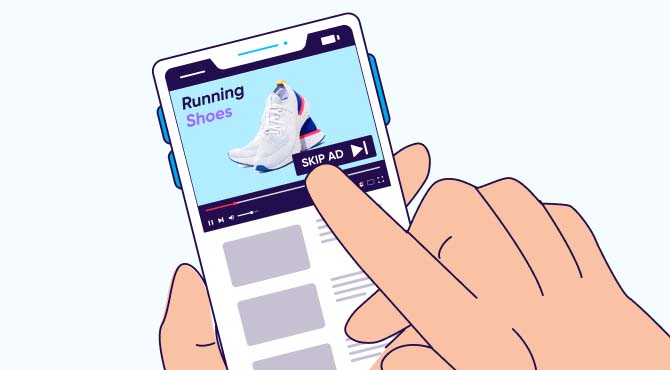
It might seem counterintuitive to let viewers skip your ad after a few seconds, rather than keeping their attention for the full length. Especially when you consider that research by DVJ Insights found that more than half of video viewers choose to skip an ad when given the option. However, brand recall suffered by less than 10% in the group that chose to skip ads.
Considering that advertisers pay less or nothing at all when their ad is skipped, you could find that skippable ads help you reap the rewards of brand recognition and a much healthier campaign ROI – not to mention happier viewers.
To give your skippable ads the best chance of success, pay close attention to the next point…
2. Front-load your brand message
In the age of short attention spans and skippable ads, viewers likely won’t give your ad their full attention — or indeed any of it. A study by Facebook found that advertisers who promote their brand name within the first three seconds of a video ad see a 23% higher aided recall than those that reveal it later or not at all.
Traditional narrative ads that don’t reveal the brand until the end don’t perform as well, with 2.4 times lower aided recall. Videos that have a strong brand presence early on (a mention rather than a small watermark, for example) see the highest recall.
A similar study by Nielsen found that viewers who watched less than 10 seconds of a video ad accounted for 74% of the campaign value, showing the high value of those early seconds of a video before users can skip.
Aided recall: a way of testing ad effectiveness where people are shown a list of brands or products as a prompt, and asked which they recall seeing.
3. Minimize interruption
Just because you can run a 60-second ad doesn’t mean it’s the best choice for your mid-roll. Keep your ad short and minimize the frequency of same-brand ads in a single show to make sure that you don’t alienate your audience.
Some brands even embrace the commercial break aspect, like an animated background playing calm music or a yoga instructor demonstrating a few stretches. Hulu recommends that its advertisers “make a clever nod to the streaming viewer and their environment or preferences”.
Matching the vibe and content of the show you’re watching is important for engagement. Since you aren’t typically hand-picking which content your ad will run in, you can use something called contextual targeting. This is an automated process that matches ads to content keywords present in the video description or transcript.
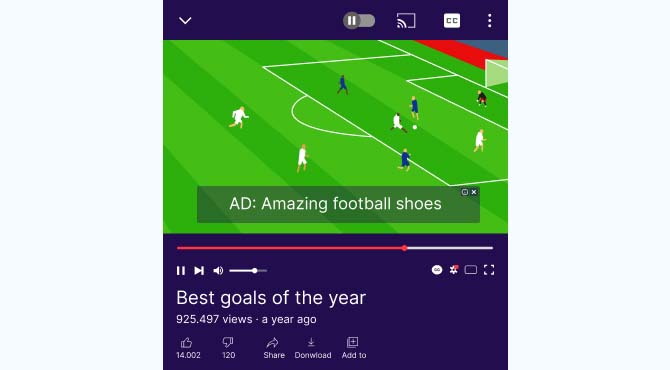
4. Leverage visual messaging
Since users may mute their TV or phone during mid-roll ads, it’s really important to use visuals to convey your message: don’t rely solely on audio. Ways you can do this include displaying text on the screen and using captivating visuals such as time-lapses or shots of a product in use.
This is even true for podcast advertising. How does that work? Well, Spotify and other providers allow for visuals including a display image, logo, background color, and call to action (CTA) button. In fact, Spotify continues to show your display creative on the podcast and episode pages for up to seven days after your ad plays.
Your CTA button is your most important visual asset, so its placement matters. You might assume the CTA belongs at the end of your ad, and it’s true this is the most popular choice. But video hosting company Wistia found that mid-roll CTAs (which can be placed anywhere in the ad apart from the very start or end) have higher conversion rates (16.95%) than CTAs at the start or end of videos, at 3.15% and 10.98% respectively.
5. Make it interactive
Publishers are creating ways for brands to interact with viewers, by letting viewers interact with the ads. One example of this is a playable ad for a gaming app, which shows a short lead-in video, then lets the viewer play a short preview of the game.
Some publishers have added polls, challenges, and quizzes that users can respond to. YouTube, for instance, allows advertisers to publish custom end screens with links, related videos, and scrollable product feeds.
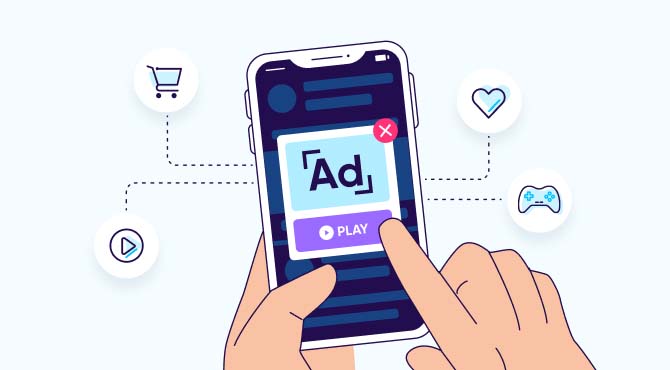
In an OTT ad, imagine a “choose your own adventure” narrative ad where you get to choose what a character does next. The potential impact for interactive ads is huge: Hulu reports that interactive ad units achieved a 50% increase in ad recall and a 45% increase in purchase intent.
6. Fit the creative to the platform
Mid-roll ads aren’t one-size-fits-all. A 30-second ad designed to run during an hour-long TV show is far different from a 30-second mobile ad running on Facebook. Consider your target placement when planning your creative for top performance.
For instance, a study by Facebook found that the best-performing mobile ads run around 20 seconds long and are designed for sound-off. Mobile video ads should follow other best practices like interactivity and portrait orientation. Narrative ads tend to do well in OTT streaming since viewers are looking to be entertained.
The bottom line: should you use mid-roll ads?
As we’ve discussed, mid-roll ads are a great way to capture a passive audience and reinforce messaging with recurring spots. While there are some downsides, like lower click-through rates, mid-roll ads are one more tactic for marketers to reach audiences where they spend the most time.
The average person watches more than 17 hours of online video a week in 2023 (up from just 10.5 hours in 2018). There are now 464.7 million podcast listeners worldwide, with 80% listening to all or most of every episode they start. Consumption for these media formats will only grow.
Engaging these audiences will help you grow brand awareness with users across channels. According to a Wyzowl report, 95% of marketers say that video has helped to grow their brand awareness and 90% say it drives leads.
Key takeaways
- Popular platforms like YouTube, Facebook, and Spotify offer placements for video and audio ads in the middle of content, known as mid-roll ads.
- The benefits of mid-roll ads include high completion rates, good brand recall, and the opportunity to tell a story or reinforce a marketing message with an already-engaged audience.
- To minimize the interruptive nature of mid-roll ads, use strategies like contextual targeting and allow skipping (get your brand in early to support recall).
- To boost engagement and leads, add interactive elements like playable elements, quizzes, and CTA buttons.
- The best mid-roll ads are around 20 seconds long, designed for sound off, and reveal the brand within the first three seconds.




